FrameLayout–帧布局
相当于动画的一帧一帧的覆盖原来的控件
<?xml version="1.0" encoding="utf-8"?>
<FrameLayout xmlns:android="http://schemas.android.com/apk/res/android"
android:layout_width="match_parent" android:layout_height="match_parent">
<Button
android:layout_height="200dp"
android:layout_width="200dp"
android:background="#00df00"/>
<Button
android:layout_width="100dp"
android:layout_height="100dp"
android:background="#ffee00"/>
</FrameLayout>TableLayout–表格布局
属性均写在 TableLayouot 里面
<TableLayout xmlns:android="http://schemas.android.com/apk/res/android"
android:layout_width="match_parent" android:layout_height="match_parent"
android:collapseColumns="1"
android:shrinkColumns="1"
android:stretchColumns="1"
>collapsColumns隐藏列,下标从0开始
android:collapseColumns=”1”
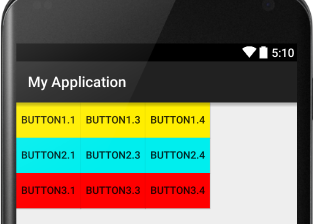
stretchColumns扩展列,下标从0开始,该列可以向行方向伸展,最多可占据一整行。
android:stretchColumns=”0”
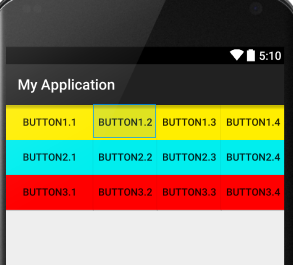
shrinkColumns收缩,下标从0开始,当该列子控件的内容太多,已经挤满所在行,那么该子控件的内容将往列方向显示。
android:shrinkColumns=”1”
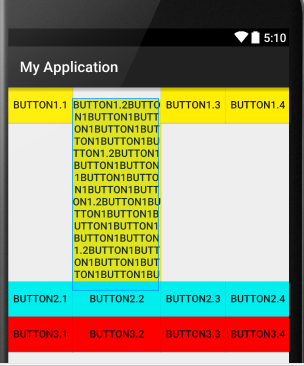
单元格属性
android:layout_span=”1” 指定该单元格占据的列数(未指定时,为1)、
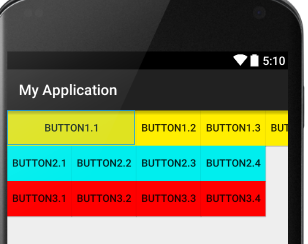
android:layout_column =“xx“指定该单元格在第几列显示
Activity的操作
1、直接启动activity
Intent intent=new Intent(MainActivity.this,SecondActivity.class);
startActivity(intent);
protected void onCreate(Bundle savedInstanceState) {
super.onCreate(savedInstanceState);
setContentView(R.layout.activity_hide);
Button button_next=(Button)findViewById(R.id.button_next);
button_next.setOnClickListener(new View.OnClickListener() {
@Override
public void onClick(View v) {
Intent intent_next=new Intent(ThirdActivity.this,MainActivity.class);
startActivity(intent_next);
}
});
}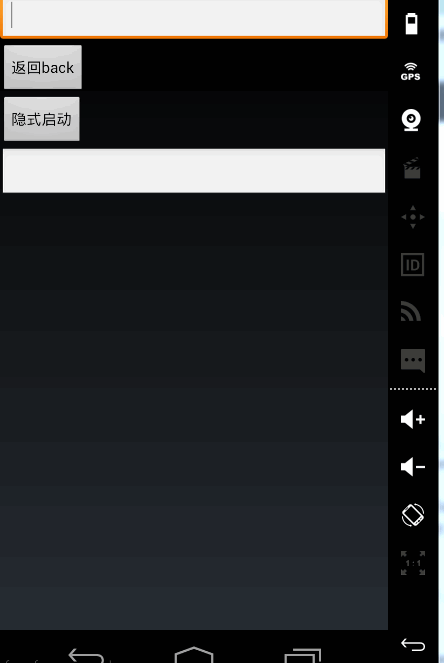
>
2、带有返回值得启动activity
API中有介绍第一个界面调用startActivityForResult(intent,requestCode)
第二个界面先调用getIntent()得到启动的intent
在关闭第二个界面前先封装数据
intent.putExtra(“secondbackdata”,editText.getText().toStrig);
设置resultCode setResult(RESULT_OK,intent);
关闭第二个界面
第一个界面准备接收数据重写
onActivityResult(requestCode,resultCode,Intent data)
判断resultCode然后从data中取出数据
Intent intent=new Intent(MainActivity.this,SecondActivity.class);
startActivityForResult(intent,0x23);
protected void onCreate(Bundle savedInstanceState) {
super.onCreate(savedInstanceState);
setContentView(R.layout.activity_main);
textView=(TextView)findViewById(R.id.textView1);
Button button=(Button)findViewById(R.id.button);
button.setOnClickListener(new View.OnClickListener() {
@Override
public void onClick(View v) {
Intent intent=new Intent(getApplicationContext(),SecondActivity.class);
startActivityForResult(intent, 1);
}
}); protected void onActivityResult(int requestCode, int resultCode, Intent data) {
switch(requestCode){
case 1:if (resultCode==RESULT_OK){
String returnnddate=data.getStringExtra("respond");
Log.d("My Application",returnnddate);
textView.setText(returnnddate);
}
break;
default:
}
}setContentView(R.layout.activity_second);
final EditText editText=(EditText)findViewById(R.id.edit_text);
Button button=(Button)findViewById(R.id.button_back);
button.setOnClickListener(new View.OnClickListener() {
@Override
public void onClick(View v) {
Intent intent=new Intent();
intent.putExtra("respond",editText.getText().toString());
setResult(RESULT_OK,intent);
SecondActivity.this.finish();
}
});设置全屏,横、竖屏切换
1、android:theme=”@android:style/Theme.NoTitleBar.Fullscreen”设置全屏
<activity
android:name=".SecondActivity"
android:theme="@android:style/Theme.NoTitleBar.Fullscreen">
<intent-filter>
<action android:name="com.example.administrator.myapplication"/>
<category android:name="android.intent.category.LAUNCHER"/>
</intent-filter>
</activity>2、requestWindowFeature(Window.FEATURE_NO_TITLE);
getWindow().setFlags(WindowManager.LayoutParams.FLAG_FULLSCREEN,WindowManager.LayoutParams.FLAG_FULLSCREEN);
注意的是通过这种方法实现的时候需要将以上两方法执行在setContentView之前才有效。(有待。。。。)
横竖屏切换
android:screenOrientation=”xx” 设置横竖屏切换
android:screenOrientation=”landscape”设置为横屏
<activity
android:name=".SecondActivity"
android:theme="@android:style/Theme.NoTitleBar.Fullscreen"
android:screenOrientation="landscape">
<intent-filter>
<action android:name="com.example.administrator.myapplication"/>
<category android:name="android.intent.category.LAUNCHER"/>
</intent-filter>
</activity>android:screenOrientation=”portrait”设置为竖屏
<activity
android:name=".ThirdActivity"
android:theme="@android:style/Theme.NoTitleBar.Fullscreen"
android:screenOrientation="portrait">
<intent-filter>
<action android:name="com.example.administrator.myapplication"/>
<category android:name="android.intent.category.DEFAULT"/>
</intent-filter>
</activity>Android的四大组件
Activity Service ContentProvider BroadcastReceiver(五大组件包括Intent)
Intent Android中的进行通讯的工具,类似于包裹
属性: Component
action 启动某一个特定的应用,例如:打电话
隐式启动Activity
被启动的界面中在manifest中添加intent_filter,在intent_filter中必须添加action,action_name自己对应,category必须填写default的
在启动界面中
category
从第二个界面返回值给第一个界面
SecondActivity界面上的代码:
protected void onCreate(Bundle savedInstanceState) {
super.onCreate(savedInstanceState);
setContentView(R.layout.activity_second);
final EditText editText=(EditText)findViewById(R.id.edit_text);
Button button=(Button)findViewById(R.id.button_back);
button.setOnClickListener(new View.OnClickListener() {
@Override
public void onClick(View v) {
Intent intent=new Intent();
intent.putExtra("respond",editText.getText().toString());
setResult(RESULT_OK,intent);
SecondActivity.this.finish();
}
});
Button button5=(Button)findViewById(R.id.button_hide);
button5.setOnClickListener(new View.OnClickListener() {
@Override
public void onClick(View v) {
Intent intent=new Intent();
intent.setAction("com.example.administrator.myapplication");
intent.putExtra("respond",editText.getText().toString());
setResult(RESULT_OK,intent);
SecondActivity.this.finish();
startActivity(intent);
}
});
Log.d("My Application","第二个界面运行到onCreate");
}MainActivity 上的代码:
protected void onCreate(Bundle savedInstanceState) {
super.onCreate(savedInstanceState);
// requestWindowFeature(Window.FEATURE_NO_TITLE);
// getWindow().setFlags(WindowManager.LayoutParams.FLAG_FULLSCREEN,WindowManager.LayoutParams.FLAG_FULLSCREEN);
setContentView(R.layout.activity_main);
textView=(TextView)findViewById(R.id.textView1);
Button button=(Button)findViewById(R.id.button);
button.setOnClickListener(new View.OnClickListener() {
@Override
public void onClick(View v) {
Intent intent=new Intent(getApplicationContext(),SecondActivity.class);
startActivityForResult(intent, 1);
}
});
protected void onActivityResult(int requestCode, int resultCode, Intent data) {
switch(requestCode){
case 1:if (resultCode==RESULT_OK){
String returnnddate=data.getStringExtra("respond");
Log.d("My Application",returnnddate);
textView.setText(returnnddate);
}
break;
default:
}
}调用拨打电话界面
MainActivity 中protected void onCreate(Bundle savedInstanceState) 里的代码:
Button button1=(Button)findViewById(R.id.button1);
button1.setOnClickListener(new View.OnClickListener() {
@Override
public void onClick(View v) {
Intent intent=new Intent();
intent.setAction(Intent.ACTION_DIAL);
intent.setData(Uri.parse("tel:10086"));
startActivity(intent);
}
});直接拔打电话
MainActivity 中protected void onCreate(Bundle savedInstanceState) 里的代码:
Button button2=(Button)findViewById(R.id.button2);
button2.setOnClickListener(new View.OnClickListener() {
@Override
public void onClick(View v) {
Intent intent=new Intent();
intent.setAction(Intent.ACTION_CALL);
intent.setData(Uri.parse("tel:10086"));
startActivity(intent);
}
});发短信
MainActivity 中protected void onCreate(Bundle savedInstanceState) 里的代码:
Button button3=(Button)findViewById(R.id.button3);
button3.setOnClickListener(new View.OnClickListener() {
@Override
public void onClick(View v) {
Intent intent=new Intent();
intent.setAction(Intent.ACTION_SENDTO);
intent.setData(Uri.parse("smsto:10086"));
intent.putExtra("sms_body","The SMS text");
startActivity(intent);
}
});打开浏览器浏览网页
MainActivity 中protected void onCreate(Bundle savedInstanceState) 里的代码:
Button button4=(Button)findViewById(R.id.button4);
button4.setOnClickListener(new View.OnClickListener() {
@Override
public void onClick(View v) {
Intent intent=new Intent();
intent.setAction(Intent.ACTION_VIEW);
intent.setData(Uri.parse("http://www.baidu.com"));
startActivity(intent);
}
});隐式调用
MainActivity 中protected void onCreate(Bundle savedInstanceState) 里的代码:
Button button5=(Button)findViewById(R.id.button5);
button5.setOnClickListener(new View.OnClickListener() {
@Override
public void onClick(View v) {
Intent intent=new Intent();
intent.setAction("com.example.administrator.myapplication");
startActivity(intent);
}
});AndroidManifest.xml中的代码
<?xml version="1.0" encoding="utf-8"?>
<manifest xmlns:android="http://schemas.android.com/apk/res/android"
package="com.example.administrator.myapplication"
>
<uses-permission android:name="android.permission.CALL_PHONE"/>
<uses-permission android:name="android.permission.send_sms"/>
<application
android:allowBackup="true"
android:icon="@mipmap/ic_launcher"
android:label="@string/app_name"
android:theme="@style/AppTheme"
>
<activity
android:name=".MainActivity"
android:label="@string/app_name"
>
<intent-filter>
<action android:name="android.intent.action.MAIN" />
<category android:name="android.intent.category.LAUNCHER" />
</intent-filter>
</activity>
<activity
android:name=".SecondActivity"
android:theme="@android:style/Theme.NoTitleBar.Fullscreen"
android:screenOrientation="portrait">
<intent-filter>
<action android:name="com.example.administrator.myapplication"/>
<category android:name="android.intent.category.LAUNCHER"/>
</intent-filter>
</activity>
<activity
android:name=".ThirdActivity"
android:theme="@android:style/Theme.NoTitleBar.Fullscreen"
android:screenOrientation="landscape">
<intent-filter>
<action android:name="com.example.administrator.myapplication"/>
<category android:name="android.intent.category.DEFAULT"/>
</intent-filter>
</activity>
</application>
</manifest>按钮组件的代码
<RelativeLayout xmlns:android="http://schemas.android.com/apk/res/android"
xmlns:tools="http://schemas.android.com/tools" android:layout_width="match_parent"
android:layout_height="match_parent" android:paddingLeft="@dimen/activity_horizontal_margin"
android:paddingRight="@dimen/activity_horizontal_margin"
android:paddingTop="@dimen/activity_vertical_margin"
android:paddingBottom="@dimen/activity_vertical_margin" tools:context=".MainActivity"
>
<TextView android:text="@string/hello_world" android:layout_width="wrap_content"
android:layout_height="wrap_content"
android:id="@+id/textView2" />
<TextView android:text="@string/hello_world" android:layout_width="wrap_content"
android:layout_height="wrap_content"
android:id="@+id/textView1"
android:layout_below="@+id/button"
/>
<Button
android:layout_width="wrap_content"
android:layout_height="wrap_content"
android:text="点击启动第二个界面"
android:id="@+id/button"
android:layout_below="@+id/textView2"
android:layout_alignParentLeft="true"
android:layout_alignParentStart="true"
android:layout_marginTop="22dp" />
<Button
android:layout_height="wrap_content"
android:layout_width="wrap_content"
android:text="拨打电话"
android:layout_marginLeft="150dp"
android:layout_marginTop="40dp"
android:id="@+id/button1"
/>
<Button
android:layout_height="wrap_content"
android:layout_width="wrap_content"
android:text="直接拨打电话"
android:layout_marginLeft="250dp"
android:layout_marginTop="40dp"
android:id="@+id/button2"
/>
<Button
android:layout_width="wrap_content"
android:layout_height="wrap_content"
android:text="发短信"
android:id="@+id/button3"
android:layout_below="@+id/button1"
android:layout_toLeftOf="@+id/button4"
android:layout_toStartOf="@+id/button4" />
<Button
android:layout_width="wrap_content"
android:layout_height="wrap_content"
android:text="web"
android:id="@+id/button4"
android:layout_below="@+id/button1"
android:layout_alignParentRight="true"
android:layout_alignParentEnd="true" />
<Button
android:layout_width="wrap_content"
android:layout_height="wrap_content"
android:text="隐式启动"
android:id="@+id/button5"
android:layout_below="@+id/button"
android:layout_toLeftOf="@+id/button3"
android:layout_toStartOf="@+id/button3" />
</RelativeLayout>








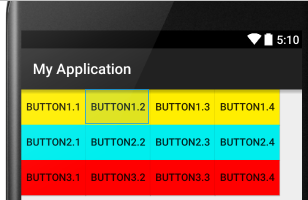
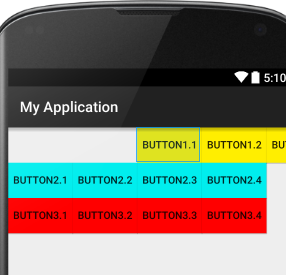
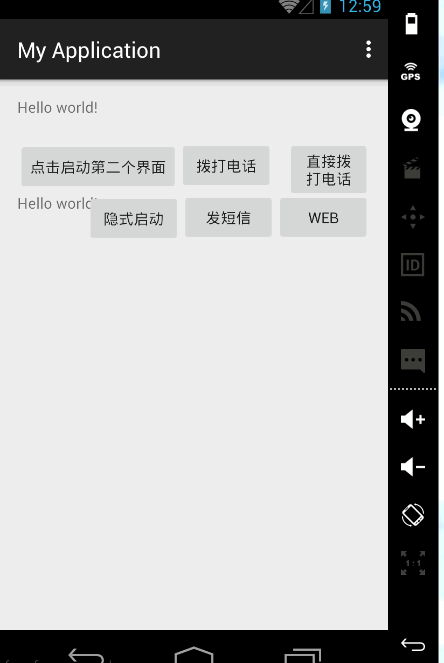
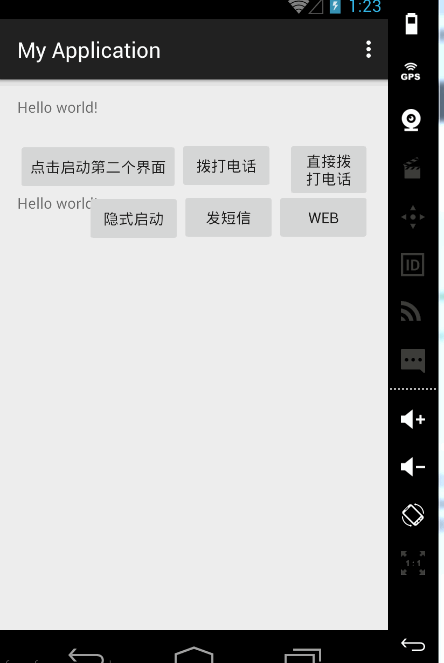

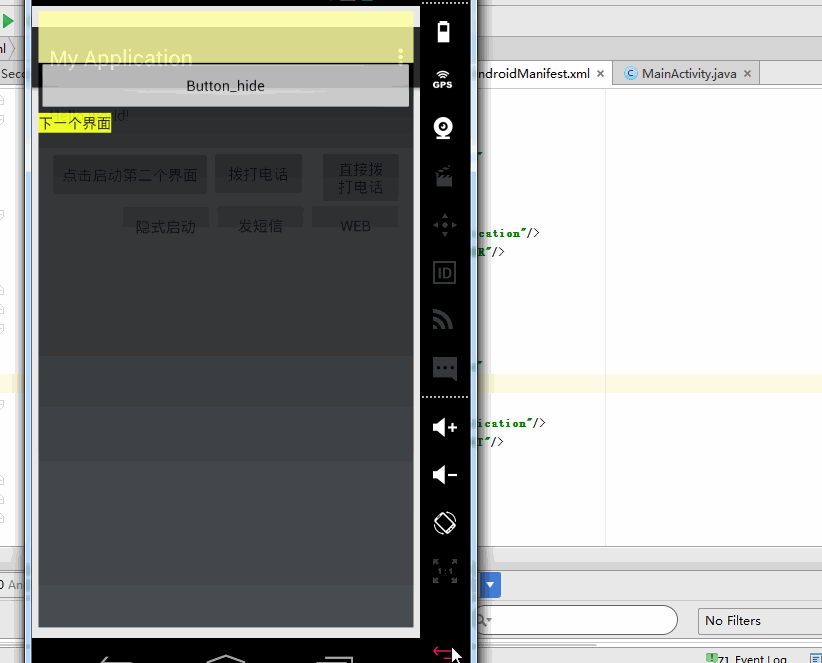
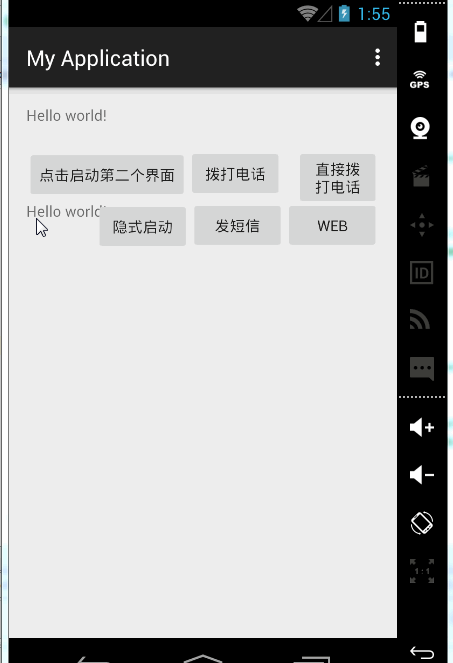
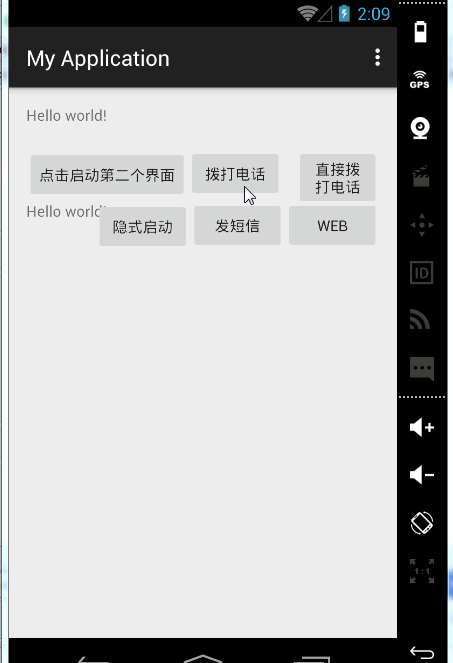
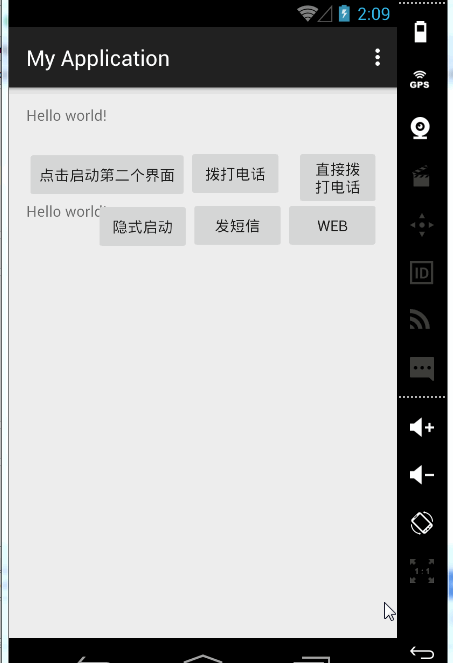
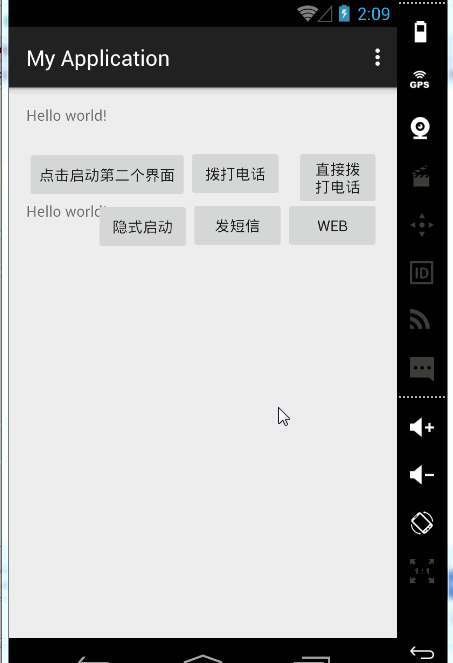
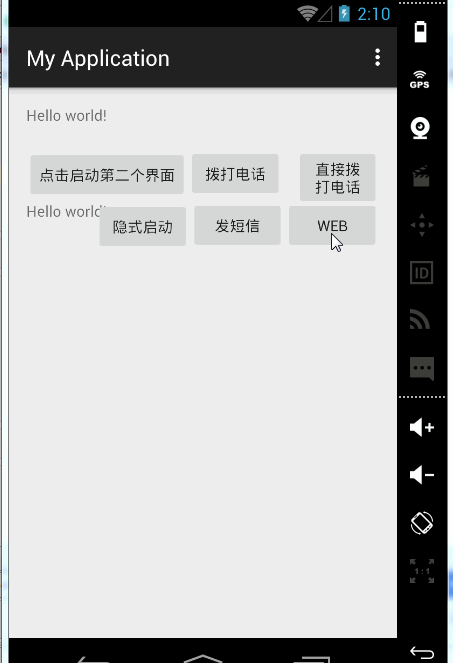
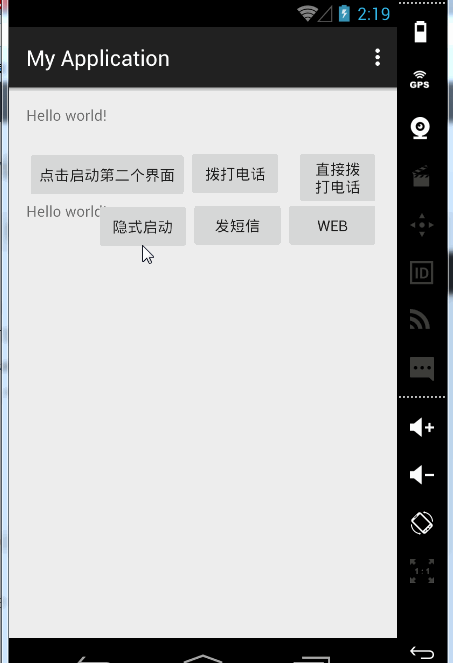














 1513
1513

 被折叠的 条评论
为什么被折叠?
被折叠的 条评论
为什么被折叠?








